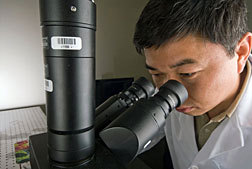- Number 379 |
- January 7, 2012
Plant architecture puzzle solved with unique imaging technology

Principal investigator Shi-You Ding.
Scientists at DOE’s National Renewable Energy Laboratory used a unique combination of imaging methods to gain unprecedented insight into the structure of cell walls in plants, a breakthrough that could lead to optimizing sugar yields and lowering costs of making biofuels.
Principal investigator Shi-You Ding and his team found that the gummy, non-sugar lignin in plants interferes with enzymes’ ability to access the polysaccharides in the cell wall – the stuff that both the enzymes and the industry want.
So, the NREL team concluded, the ideal pre-treatment of plants for biofuels should focus on getting rid of the lignin, but leaving the valuable polysaccharides within the cell walls intact. That would leave a loose, porous structure that affords enzymes easy access. And, it would be an improvement over pretreatments that remove some of the spongier carbohydrate polymers and allow the remainder to collapse into tighter structures that are tougher for enzymes to access.
In biofuels production, enzymes are needed to greatly speed up the chemical reactions that break down the biomass during fermentation. The NREL team found that the easier the access to the cell walls, the better and faster the enzymes will digest the material.
NREL’s imaging technology allowed the team of scientists – a biologist, chemists, and physicists -- to view the plants’ architecture at scales ranging from millimeter to nanometer, a range of 1 million to1.
Ding said that allowed them to learn not just the architecture, but the effect of enzyme action on the cell walls.
A paper on the breakthrough, “How Does Plant Cell Wall Nanoscale Architecture Correlate with Enzymatic Digestibility,” appears in the current issue of Science Magazine.
The NREL team worked with scientists from the BioEnergy Science Center (BESC), a multi-institutional center supported by the DOE’s Office of Biological and Environmental Research in the Office of Science.
The imaging technique gave the team a deeper understanding of the structure and the process of hydrolysis, decomposition by reaction with water, said Ding. “That allows us to optimize the process and reduce costs.”
They didn’t have to resort to wet chemistry, which ascertains the molecular makeup of a substance at the cost of destroying its architecture.
“The typical way to understand the structure of biomass is to break down all the individual components so they can be analyzed,” Ding, a biologist, said. “The problem with that method is that then you don’t know where all the components came from. You lose the structural integrity.”
That’s a crucial loss, because an understanding of how enzymes digest plants requires an understanding of where everything is inside the cell walls.
[Bill Scanlon, 303.275.4051,
william.scanlon@nrel.gov]
